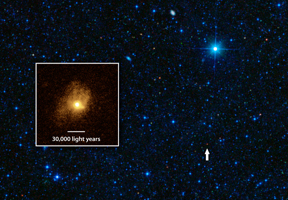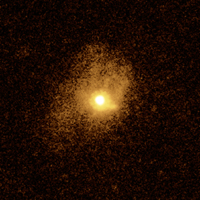 |  |
| Hubble inset | Hubble larger view |
Click on an individual image for larger viewsThe tiny red spot in this image is one of the most efficient star-making galaxies ever observed, converting gas into stars at the maximum possible rate. The galaxy is shown here in an image from NASA's Wide-field Infrared Survey Explorer (WISE), which first spotted the rare galaxy in infrared light.
Visible-light observations from NASA's Hubble Space Telescope (inset) reveal that the starlight in this galaxy is extraordinarily compact, with most of the light emitted by a region just a fraction of the size of the Milky Way galaxy. Within that tiny region, stars are forming at a rate hundreds of times that of our galaxy.
Astronomers have combined these star-formation and size measurements from WISE and Hubble, with a measurement of the amount of gas -- fuel for star formation -- from the IRAM Plateau de Bure interferometer to confirm that SDSSJ1504+54 is forming stars at the maximum theoretical rate. This is a case of star formation at its most extreme.
NASA's Jet Propulsion Laboratory, Pasadena, Calif., manages, and operated WISE for NASA's Science Mission Directorate. The spacecraft was put into hibernation mode after it scanned the entire sky twice, completing its main objectives. Edward Wright is the principal investigator and is at UCLA. The mission was selected competitively under NASA's Explorers Program managed by the agency's Goddard Space Flight Center in Greenbelt, Md. The science instrument was built by the Space Dynamics Laboratory in Logan, Utah. The spacecraft was built by Ball Aerospace & Technologies Corp. in Boulder, Colo. Science operations and data processing take place at the Infrared Processing and Analysis Center at the California Institute of Technology in Pasadena. Caltech manages JPL for NASA.
More information is online at http://www.nasa.gov/wise and http://wise.astro.ucla.edu.

